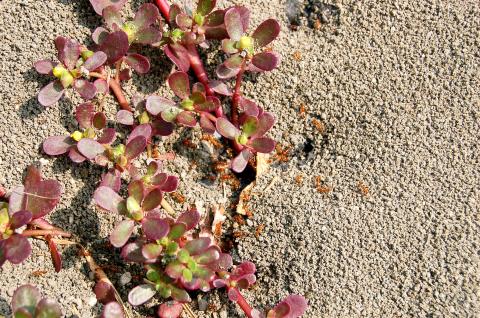The total area in Taiwan affected by exotic red fire ants has increased by nearly 50 percent since 2003, but despite the growing infestation, the government budget for pest control was cut from last year’s NT$40 million (US$1.36 million) to NT$20 million this year.
Listed among the world’s top 100 most-invasive species, the ants, native to South America, were discovered in Taiwan in 2003 and have alarmed residents by quickly spreading through urban areas in Greater Taipei, Taoyuan, Hsinchu, Miaoli and Chiayi counties.
The ants not only pose a serious threat to Taiwanese ecology, but the necrotizing alkaloid in their venom can cause a blister or pustule — which earned them their name — that can cause a person to go into shock or can even be fatal if the person is allergic.

Photo: Chen Tsan-kun, Taipei Times
In 2004, the Council of Agriculture (COA) established a national red exotic fire ant prevention center tasked with containing the spread of the ants within a 36,000-hectare radius, but last year the center increased its containment area to 55,000 hectares.
According to the center, in 2007 there were 1,619 known locations of red fire ant activity, but last year known locations had increased to 2,440. The center said that in five years, Hsinchu County alone had seen an increase from 23 locations to 244, while New Taipei City (新北市) saw a 250 percent increase in ant activity, going up from 177 locations to 453.
National red fire ant prevention center director Huang Rong-nan (黃榮南) said that when the ants were accidentally introduced to Australia in 2001, the total infected area stood at about 60,000 to 70,000 hectares. The Australian government assigned a team of 600 people to combat the pests, and even used planes to spray a pesticide to contain them.
Taiwan, on the other had, has insufficient manpower to contain the ants, he said.
Huang Chi-sen (黃基森), a professor at National Taipei University of Education’s Program of Environmental Education and Resources, has been monitoring the activities of the ants for many years. Huang said that because of Taiwan’s geography, prevention and control of the ants would prove to be difficult.
“Now that the funding has been slashed, I’m afraid that it will be increasingly difficult to contain the ants,” he said.
The government should not give up, Huang said, because between 7 million and 8 million people live in the infested area. Huang said that the US suffers US$5 billion in losses per year because of the ants.
In response to why the COA was slashing funding for ant prevention, Fei Wen-chi (費雯綺) of the Bureau of Animal and Plant Health Inspection and Quarantine said the budget cut was the result of financial troubles at the central government.
Despite the financial difficulties, the budget was still enough to ensure high-level prevention and containment, Fei said, adding that the council would employ alternative methods to contain the ants.
“We have adjusted our strategies for this year,” she said. “While Taoyuan County will be under full prevention and containment as a ‘heavy disaster’ area, the bureau will treat other infested areas as hotspots and adjust its strategy accordingly.”
Translated by Jake Chung, staff writer

Chinese Nationalist Party (KMT) Chairman Eric Chu (朱立倫), spokeswoman Yang Chih-yu (楊智伃) and Legislator Hsieh Lung-chieh (謝龍介) would be summoned by police for questioning for leading an illegal assembly on Thursday evening last week, Minister of the Interior Liu Shyh-fang (劉世芳) said today. The three KMT officials led an assembly outside the Taipei City Prosecutors’ Office, a restricted area where public assembly is not allowed, protesting the questioning of several KMT staff and searches of KMT headquarters and offices in a recall petition forgery case. Chu, Yang and Hsieh are all suspected of contravening the Assembly and Parade Act (集會遊行法) by holding

PRAISE: Japanese visitor Takashi Kubota said the Taiwanese temple architecture images showcased in the AI Art Gallery were the most impressive displays he saw Taiwan does not have an official pavilion at the World Expo in Osaka, Japan, because of its diplomatic predicament, but the government-backed Tech World pavilion is drawing interest with its unique recreations of works by Taiwanese artists. The pavilion features an artificial intelligence (AI)-based art gallery showcasing works of famous Taiwanese artists from the Japanese colonial period using innovative technologies. Among its main simulated displays are Eastern gouache paintings by Chen Chin (陳進), Lin Yu-shan (林玉山) and Kuo Hsueh-hu (郭雪湖), who were the three young Taiwanese painters selected for the East Asian Painting exhibition in 1927. Gouache is a water-based

Taiwan would welcome the return of Honduras as a diplomatic ally if its next president decides to make such a move, Minister of Foreign Affairs Lin Chia-lung (林佳龍) said yesterday. “Of course, we would welcome Honduras if they want to restore diplomatic ties with Taiwan after their elections,” Lin said at a meeting of the legislature’s Foreign Affairs and National Defense Committee, when asked to comment on statements made by two of the three Honduran presidential candidates during the presidential campaign in the Central American country. Taiwan is paying close attention to the region as a whole in the wake of a

OFF-TARGET: More than 30,000 participants were expected to take part in the Games next month, but only 6,550 foreign and 19,400 Taiwanese athletes have registered Taipei city councilors yesterday blasted the organizers of next month’s World Masters Games over sudden timetable and venue changes, which they said have caused thousands of participants to back out of the international sporting event, among other organizational issues. They also cited visa delays and political interference by China as reasons many foreign athletes are requesting refunds for the event, to be held from May 17 to 30. Jointly organized by the Taipei and New Taipei City governments, the games have been rocked by numerous controversies since preparations began in 2020. Taipei City Councilor Lin Yen-feng (林延鳳) said yesterday that new measures by